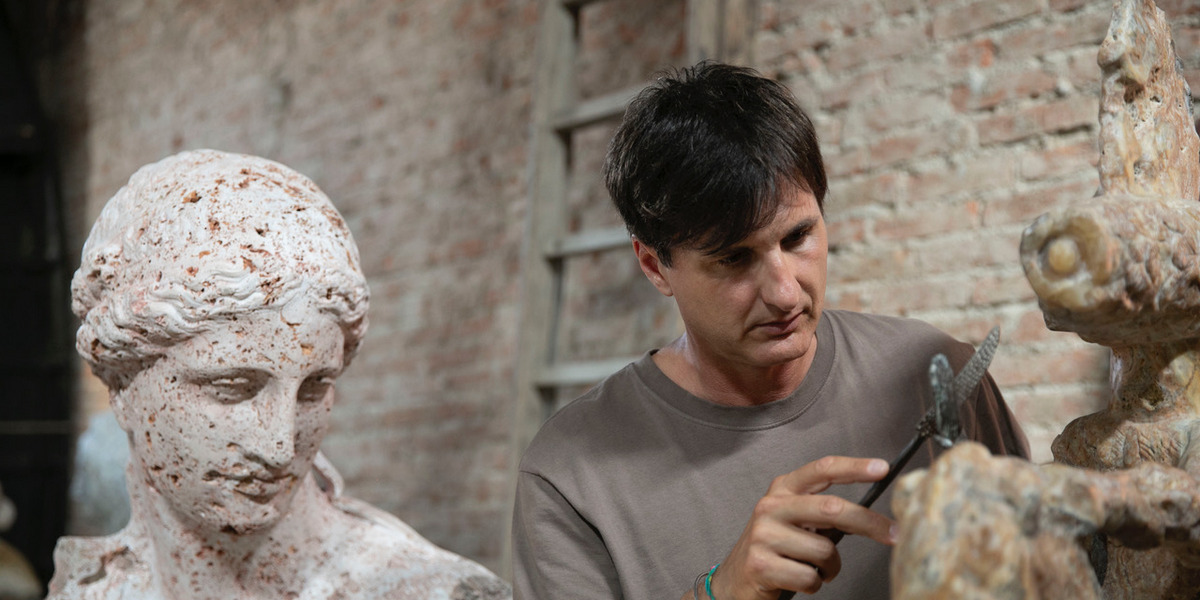Born on January 27, 1975, in the quaint Italian town of Pietrasanta, located in the province of Lucca, Massimiliano Pelletti has spent his life and creative career in this locale. The artist’s initial exposure to the craft of working with marble can be traced back to his early years, under the tutelage of his paternal grandfather, Mario. The workshop operated by his family served as a cradle for his early artistic endeavors, where he acquired skills in manipulating marble.
Pelletti’s formal education in art commenced at the Stagio Stagi Art School, located in his hometown of Pietrasanta. However, he didn’t limit his intellectual pursuits to just the artistic domain; he expanded his academic horizons by pursuing and eventually earning a degree in Philosophy from the University of Pisa. This field of study left a lasting impact on Pelletti, not only intellectually but also artistically, subtly influencing the themes and techniques he would later employ in his work.
The artist burst onto the international stage in 2006, when he clinched the top prize at the 12th Biennale of Young Artists from Europe and the Mediterranean. This marked the beginning of a career punctuated by participation in numerous high-profile exhibitions. For instance, Pelletti showcased his work at the Alexandria Biennale in Egypt as well as the prestigious 54th Venice Biennale, where his contributions were part of the Italian Pavilion curated by the renowned art critic Vittorio Sgarbi.
While Pelletti’s initial works predominantly featured marble—a material abundant and culturally significant in his region of Italy—he didn’t limit himself to this single medium. As his art evolved, he began incorporating a myriad of other natural stones such as quartz, onyx, and limestone. This innovative approach showcased his commitment to expand the possibilities of sculpture, while also paying homage to traditional techniques he had learned as a young boy. Notably, Pelletti managed to maintain a connection to his roots through a valuable collection of classical plaster models that had once belonged to his grandfather.
In 2014, Pelletti’s accomplishments were further recognized when he received the Henraux Foundation International Sculpture Award, under the curation of Philippe Daverio. Over the years, his sculptures have graced various museums and public spaces including, but not limited to, Villa Croce and Sant’Agostino in Genoa, the Abbey of San Zeno in Pisa, and the Temple of Hadrian in Rome. He has also contributed articles to art journals, affirming his position not just as an artist but as a thought leader in contemporary art.
The year 2017 was particularly noteworthy for Pelletti. He staged a solo exhibition, “Sacra Privata,” at the Galleria Barbara Paci in Pietrasanta. This exhibit, curated by Flavio Arensi, garnered Pelletti significant attention and accolades from art critics and leading publications in the contemporary art world.
Pelletti’s artistic journey has been marked by participation in significant exhibitions, including “Ecce Homo da Marino Marini a Mimmo Paladino – La scultura di figura in Italia” at the Mole Vanvitelliana in Ancona and “L’immagine del suono,” an exploration of the intersection between visual arts and music. His work was also featured in the Museum of Archaeology and Art of Maremma, and in 2018, he participated in “Il passo sospeso. Esplorazioni del limite” at the Fondazione Ragghianti in Lucca. Moreover, since 2017, his works have been showcased in elite art fairs like SCOPE Miami, SCOPE New York, ART MIAMI in the U.S., as well as international platforms like the Investec Cape Town Art Fair in South Africa and Wopart in Lugano, Switzerland.
In 2019, a collaboration between the Italian fashion brand Roberto Cavalli and the Mexican development company Peninsula led to Pelletti being commissioned for a monumental sculpture, towering nearly 5 meters, crafted in Carrara white marble for an urban project in Acapulco, Mexico. The following year, he made another significant public art contribution: a monumental marble sculpture that now adorns a central roundabout in the town of Forte dei Marmi, serving as a testament to his enduring relationship with his native area of Versilia.
In recent years, Pelletti’s work has continued to gain international prominence. He inaugurated a solo exhibition in 2020 at the MARCA in Catanzaro titled ‘Looking forward to the Past.’ Then, in 2021, his exhibition “Gazing of Tranquility” opened at the Zhejiang Art Museum in Shanghai and is slated to travel through other major Chinese museums like the Wuhan Art Museum and the Guangdong Museum of Art. Also, in December of that year, he was involved in the exhibition “Canova. Tra innocenza e peccato” at the MART in Rovereto, which came to fruition from an idea by Vittorio Sgarbi and was curated by Beatrice Avanzi and Denis Isaia.
Massimiliano Pelletti’s evolving body of work, commitment to innovation, and deeply rooted connection to his Italian heritage make him a multifaceted artist worthy of the international acclaim he has received. His blend of classical techniques, modern artistic sensibilities, and philosophical undertones exemplify a mastery and complexity that has endeared him to both critics and audiences alike.
